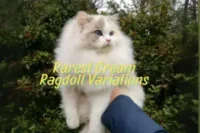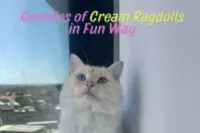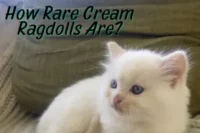Blue Point Ragdoll Cats: Colors, Care, Prices & Name Ideas
Published: 14 Aug 2025
If you ever saw a Ragdoll with a soft, dreamy gray face and sparkling blue eyes, chances are you met a Blue Point Ragdoll and oh, what a sight they are! We consider ourselves lucky enough to share our home (and our laps) with a few of these cloud-colored cuddle bugs and let us tell you… they have a way of stealing hearts faster than you can say “Who’s a good kitty?” 🐾
Blue Point Ragdolls aren’t just beautiful; they are gentle, affectionate and full of little quirks that make every day brighter. From their slow kitten-to-adult color change to their love for flopping at your feet, these cats are the ultimate combination of elegance and sweetness.
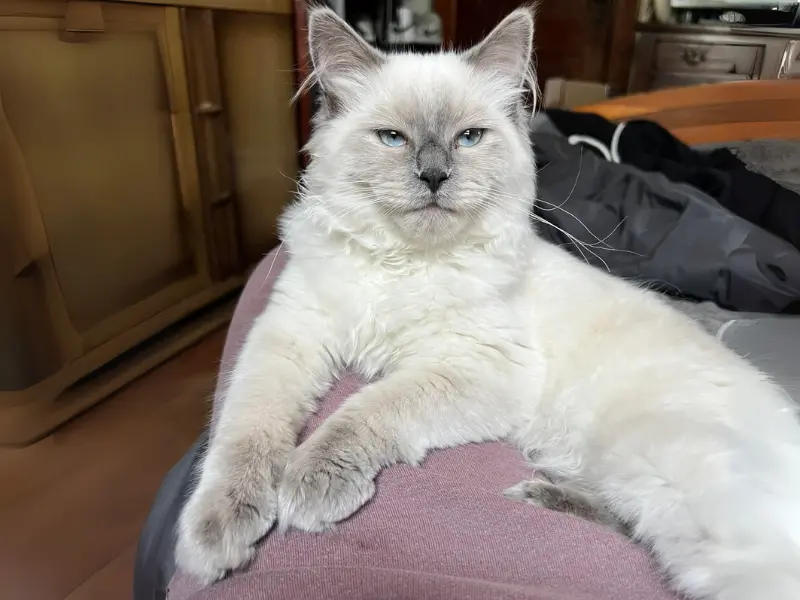
In this guide, we are sharing everything we’ve learned from living, loving and caring for Blue Point Ragdolls—from recognizing their gorgeous coat patterns to choosing the purr-fect name, finding a healthy kitten and giving them the best possible care.
So, whether you’re just curious about these fluffy beauties or thinking about adding one to your family, pour yourself a cup of tea, curl up with your current cuddle buddy and let’s explore the wonderful world of Blue Point Ragdolls together.
Blue Point Ragdoll 101: What Makes Them So Special?
If you are new to Ragdoll colors, the term Blue Point might sound a little funny. Does it mean your cat will actually be blue? Not quite! In the cat-world, “blue” is a soft, silvery gray color and “points” are the darker areas on the face, ears, legs and tail. Put the two together and you get the dreamy look of a Blue Point Ragdoll.
We still remember the first time we saw a Blue Point kitten—she was a tiny ball of cream fluff with just the faintest shadow of gray on her ears. Over the next year, her points deepened into a rich slate-gray mask and tail, while her body stayed a light, cool-toned beige. Watching that transformation felt like magic unfolding right in our living room.
The Signature Blue Point Look
A Blue Point Ragdoll will usually have:
- Soft gray points– on the face, ears, tail and legs
- Cool, creamy body color– lighter in contrast to the points
- Bright blue eyes– a hallmark of all traditional Ragdolls
- Silky, semi-long fur– smooth to the touch and surprisingly easy to maintain
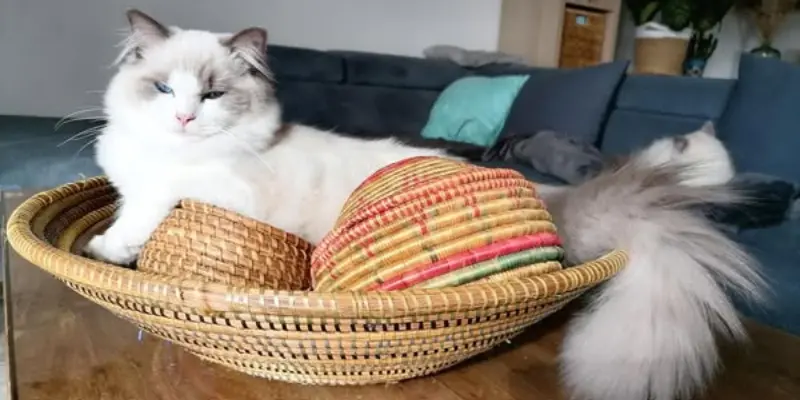
And yes, the color changes over time! Blue Points are born almost pure white and their points slowly appear and darken as they grow. By the time they are about two years old, you will see their full beauty but even then, their shades can shift slightly with seasons and age.
Patterns Within the Blue Point Family
Not all Blue Points look exactly the same, there are a few patterns you might meet:
- Classic Blue Colorpoint– no white on the paws or face, just that gorgeous gray on the points.
- Blue Point Mitted– white “mittens” on the front paws and white boots on the back, plus a sweet white chin and tummy stripe.
- Blue Point Bicolor– a white inverted “V” on the face, white legs and a white belly.
We will go into each pattern in detail later in the section of this article but for now, just know that all of them share the same soft gray-blue points and cool body tones.
The Blue Point Look From Whiskers to Toe Beans
One of the best parts of living with a Blue Point Ragdoll is simply looking at them. Every time they walk into the room, we can’t help but pause and admire their elegance. It’s like having a living, purring work of art curled up on your couch.
Their Dreamy Color Palette
Blue Points have a coat that feels like it was painted by a soft-brush artist:
- Face, ears, legs and tail: a beautiful slate to steel-gray color that’s called “blue” in the cat’s fancy.
- Body: a cool, creamy beige that contrasts perfectly with the darker points.
- Nose leather and paw pads: often a matching gray tone which looks especially cute when they stretch out those little paws for a belly rub.
We have noticed that in natural sunlight, the gray points can take on a slight silvery shimmer while in the evening light, they look richer and deeper. It’s a color that feels alive by changing with the day and the season.
Those Famous Ragdoll Eyes
No matter the pattern, Blue Point Ragdolls have one thing in common: their eyes. Big, round and an unforgettable shade of blue. Sometimes we catch our cats giving us that slow blink of love and honestly, it melts us every single time.
From Kitten to Adult – The Blue Point Glow-Up
If you have never raised a Blue Point Ragdoll from kittenhood, you are in for one of the sweetest surprises in the cat world. These little fluffballs are born almost pure white and their signature blue-gray points appear slowly over the first months of life like watching nature paint a masterpiece right before your eyes.
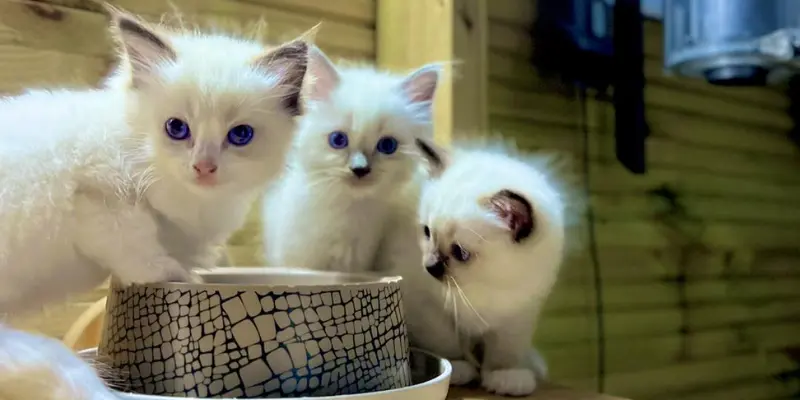
Born as Snowflakes
When our first Blue Point kitten arrived, we remember thinking, Are you sure this one’s a Blue Point? Her fur was snowy white from head to tail and the only hint of color was the faintest shadow on her ears. It’s completely normal, Ragdoll kittens develop their points after birth because their coat color is influenced by temperature. The cooler areas of their body (face, ears, paws, tail) darken first.
The First Few Months
By around 8–12 weeks, you will start to notice the gray-blue points becoming more defined. It often begins at the ears and face, then spreads to the tail and legs. We loved checking every week to see the little changes which is kind of like flipping through the pages of a living photo album.
The One-Year Mark
At about a year old, a Blue Point Ragdoll’s points are much more visible but the transformation isn’t over yet. The contrast between the creamy body and the darker points keeps developing. Some cats deepen in color faster than others, it’s a little like watching siblings grow up with their own personalities.
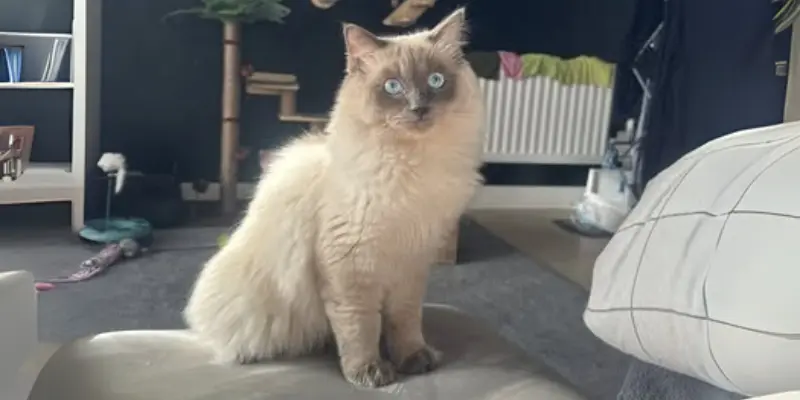
Fully Bloomed Adults
By 2–3 years old, most Blue Points reach their full color, though some will continue to darken slightly with age. Seasonal changes can also make their coats richer or lighter. In winter, we have noticed our cats’ points become a deeper steel gray while summer brings a softer tone.
The Blue Point Ragdoll Personality: Sweet, Social and Oh-So Silly
If we had to sum up a Blue Point Ragdoll’s personality in three words, it would be: loving, gentle and playful. These cats aren’t just pretty faces but they are loyal companions who weave themselves into every part of our lives.
Lap Lovers and Shadow Cats
Our Blue Points have a funny habit: wherever we go, they follow. From making breakfast to folding laundry, we’ll glance down and find those big blue eyes watching us like we are the most interesting show on earth. And the moment we sit down? Instant lap warmer.
They are often called “puppy-like” because they love being near their people. We’ve even had one who greeted us at the door like a little butler every time we came home.
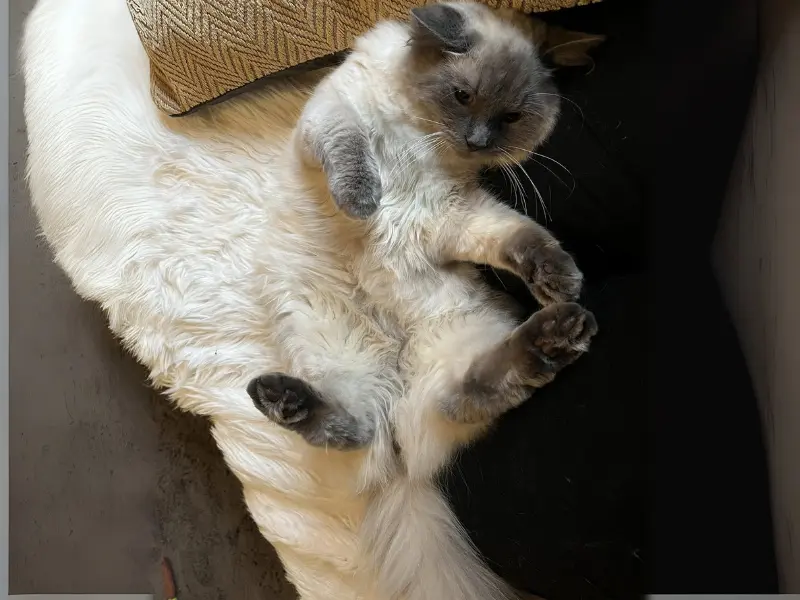
Calm Yet Playful
While Ragdolls are famously laid-back, don’t mistake that for laziness. Blue Points have their silly moments—chasing feather wands, rolling onto their backs mid-play or doing the famous “Ragdoll flop” right in your path.
Our youngest Blue Point loves to play fetch (yes, fetch!) with a crinkly toy mouse. She will drop it at our feet, meow expectantly and race after it like her tail’s on fire.
Gentle With Everyone
We have found that Blue Points are especially patient with children and polite with guests. They don’t usually mind being picked up and they seem to enjoy being part of family activities. Of course, every ragdoll cat is unique but the Blue Point temperament tends to be more “laid-back observer” than “hiding under the bed.”
Communication Style
These fluffballs are talkative in a soft, sweet way. You might hear gentle chirps, trills or tiny meows, especially around mealtime or cuddle time. It’s their way of keeping the conversation going.
Little question for you: If you have a Blue Point already, is your kitty a quiet cuddle bug or a chatty sidekick?
Coat Care & Grooming– Keeping Your Blue Point Looking Purr-fect
One of the reasons we adore Blue Point Ragdolls—aside from their sweet personalities—is that their coats are as soft as a cloud and surprisingly easy to care for. Unlike some long-haired breeds, blue point ragdolls have a silky and fine shorthair with very little undercoat which means fewer tangles and mats.
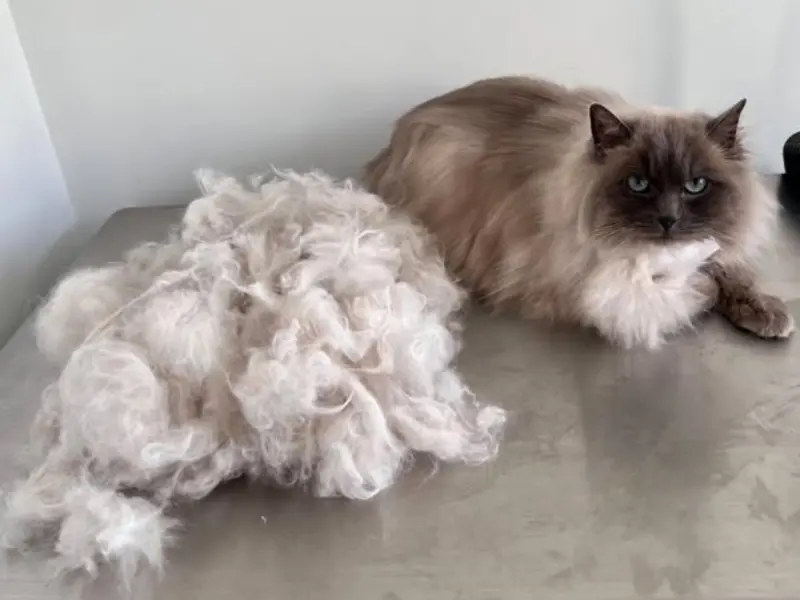
Our Weekly Grooming Routine for Shorthair Blue point ragdoll
We have found that brushing 2–3 times a week keeps our Blue Points looking and feeling their best. Here’s what works for us:
- Gentle slicker brush– perfect for removing loose hairs without pulling.
- Steel comb– great for checking the belly and under the legs where knots can sneak in.
- Short sessions– 5–10 minutes is plenty; we keep it calm and reward ourselves with treats.
Our trick? We brush right after playtime when they are relaxed or during TV time so it feels like a cozy bonding moment.
Bathing (Only If Needed)
Ragdolls are pretty good at keeping themselves clean. We only bathe ours if they have gotten into something messy and even then we use a gentle cat-safe shampoo. A quick towel dry followed by a warm snuggle session is the perfect finish.
Seasonal Shedding
We notice more loose fur in spring and fall as they shed their seasonal coats. A little extra brushing during these times keeps the fluff from floating around the house. Bonus: it also cuts down on hairballs.
Nail, Ear and Eye Care
- Nails: We trim every 2–3 weeks.
- Ears: Check once a week for dirt or wax; wipe gently if needed.
- Eyes: A soft, damp cloth works wonders for any tear stains, especially around those pale fur areas.
Tip from experience: Grooming isn’t just about looks but it’s a wonderful way to check your cat’s skin, weight and overall health. Plus, it turns into a special one-on-one time they will come to love.
Blue Point Ragdoll Price & Finding the Right Kitten
Bringing a Blue Point Ragdoll into your life is a big and exciting step. We still remember the day we met our first Blue Point kitten—tiny paws, big blue eyes and that soft purr that melted our hearts instantly. But before you rush into adopting or buying one of these cuddle buddies, it’s important to know what to expect in terms of cost and how to find a healthy, happy kitten from a responsible breeder.
How Much Does a Blue Point Ragdoll Cost?
The price can vary a lot depending on where you live, the breeder’s reputation and whether the kitten is meant for pet, show or breeding purposes. On average, here’s what we’ve seen:
- Pet-quality kittens: $800 – $1,500
- Show-quality kittens: $1,500 – $3,000+
- Rare traits or special lines: Can go higher
Pet-quality kittens are just as loving and beautiful as show-quality ones—they simply may not meet all the physical standards for cat shows (for example, a slightly different marking pattern).
What Affects the Price?
We have noticed a few common factors that can raise or lower the cost:
- Pedigree: Kittens from award-winning bloodlines tend to cost more.
- Coat & Markings: Perfect symmetry in color points or rare patterns (like mitted or bicolor) can increase the price.
- Age: Younger kittens (12–14 weeks) are usually more expensive than older kittens or retired adult cats.
- Breeder care: Reputable breeders invest in health testing, vaccines, microchipping and high-quality food, which can raise the price but is worth every penny.
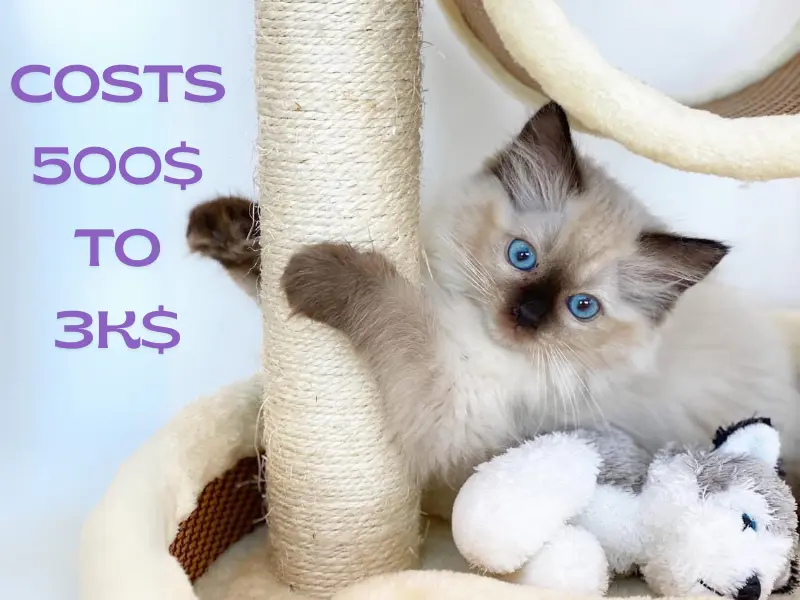
Find the Right Blue Point Ragdoll Kittens for Sale
When we were looking for our first Blue Point, we learned quickly that choosing the right breeder matters more than finding the cheapest kitten. Here’s what we always check:
- Health testing: Parents should be screened for common genetic issues like HCM (Hypertrophic Cardiomyopathy).
- Early socialization: Kittens should be raised in the home, handled daily and exposed to everyday sounds.
- Clear communication: A good breeder will happily answer your questions and send updates.
- Written contract: Covers health guarantees and return policy if you can’t keep the cat.
Where to Look
- Registered breeders with CFA or TICA listings.
- Ragdoll breed clubs – They often have breeder directories.
- Local cat shows – Great way to meet breeders in person.
Our advice: Never buy from kitten mills or breeders who won’t let you visit (or at least offer video calls). The first cuddle with your Blue Point should be filled with excitement not worry.
Blue Point Names We Love
One of our favorite parts of welcoming a Blue Point Ragdoll into the family is picking the purr-fect name. Their soft, silvery-blue points, dreamy eyes and gentle personality open up so many creative possibilities. Over the years, we have named our own kittens and helped fellow cat parents find names that truly match their fluffball’s personality and it’s always such a joyful moment.
When choosing a name, we love to think about what makes our Ragdoll special. Is it their calm, cuddly nature? Their ocean-like eyes? Or maybe that regal way they stretch out on the couch like they own the place (and let’s face it, they do!). We have put together some of our favorite Blue Point Ragdoll name ideas based on different “vibes” to help inspire you.
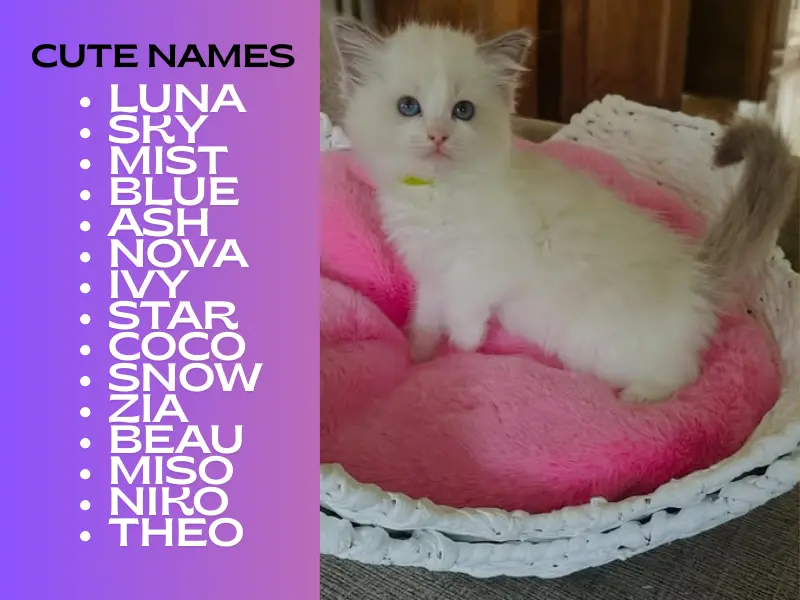
Name Lists by Vibe
Sky & Sea
Perfect for kittens with eyes like a summer sky or fur as soft as sea foam: Misty, Skye, Azure, Harbor, Drift, Zephyr, Moonbeam
Cozy & Sweet
Because some kitties are just meant to be your warm, purring lap buddy: Biscuit, Latte, Marshmallow, Noodle, Snuggles
Elegance & Myth
For Blue Points with that royal, mystical presence: Sterling, Athena, Merlin, Opal, Duchess, Titan
Cool Gray Moods
Inspired by their silvery fur and quiet, calm nature: Slate, Cinder, Pebble, Graphite, Foggy, Storm
Blue-Tinged Fun
Playful names that match their cool, bluish points: Denim, Indigo, Cobalt, Frost, Glacier, Haze
We always say—your Ragdoll will help you choose their name. Try saying a few out loud and watch their reaction. Some kittens perk up right away, as if to say, “Yes, that’s me!”
So tell us— which name makes your kitten purr the loudest? We’d love to hear in the comments!
Blue Point Ragdoll Variations
Not all Blue Point Ragdolls look exactly the same, there are a few beautiful variations that give each kitty their own unique charm. Over the years, we have been taking care of mitted, bicolor and classic colorpoint Blue Points, and trust us, every version is just as purr-fect as the next.
These variations mostly come down to where the blue-gray coloring appears on their fur and how much white they have. Let’s break it down so you can spot the differences (and maybe decide which one has your heart).
Blue Colorpoint
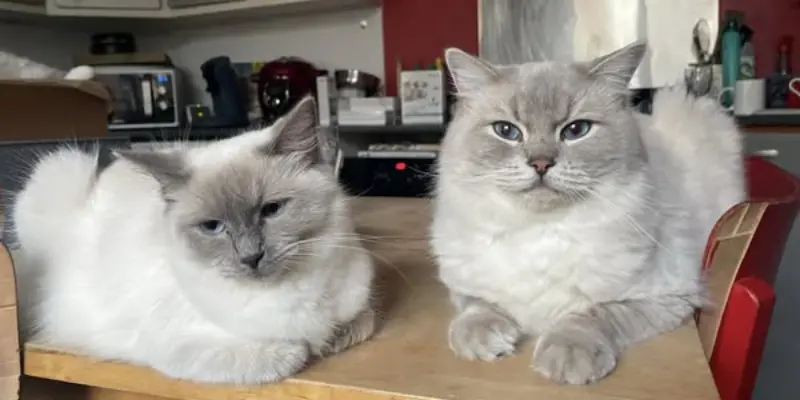
This is the “classic” Blue Point look with blue-gray coloring on the face, ears, tail and paws, with the rest of the body a lighter, creamy color. Their striking blue eyes really stand out against the soft contrast. We have always thought Colorpoints look like little feline clouds drifting around the house.
You will notice:
- No white markings on paws or face
- Soft gradient from dark points to lighter body
- That sweet, elegant look Ragdolls are famous for
Blue Point Mitted
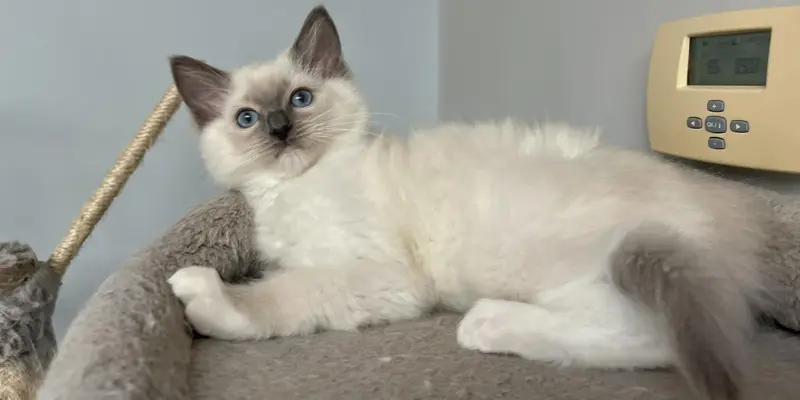
These cuties look like they are wearing tiny white socks and hence the name “mitted.” In addition to the blue-gray points, they have white on their front paws, back paws and often a white chin and belly.
You will notice:
- Adorable “mittens” on the front paws and “boots” on the back
- White stripe running from chin to belly
- Same blue-gray points on face, ears and tail
Blue Point Bicolor
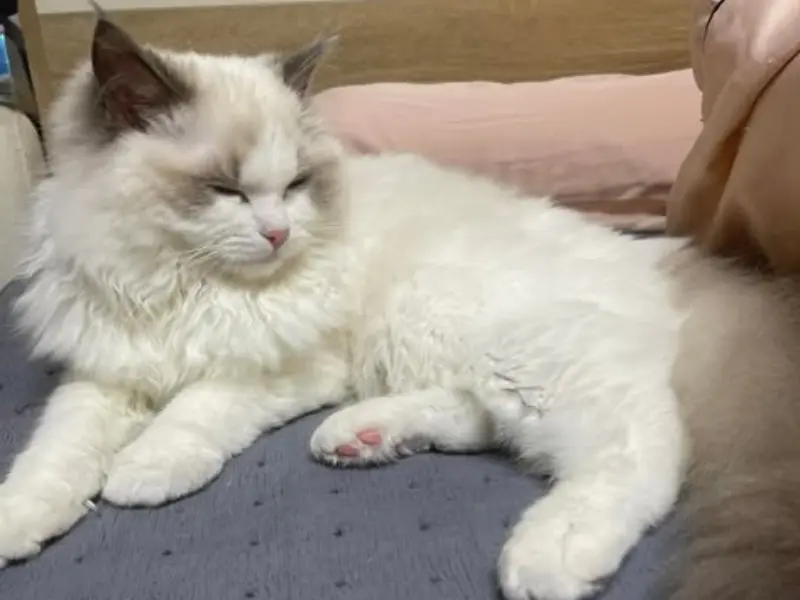
Bicolors have a unique inverted “V” of white on their faces, plus plenty of white on their chest, legs and belly. They often look extra fluffy and soft, and their markings make them stand out from the crowd.
You will notice:
- Upside-down “V” shape on the face
- More white overall than mitted or colorpoint
- An especially photogenic look (great for Social Media)
No matter which variation you choose, Blue Point Ragdolls share the same sweet, gentle personality that makes them so lovable. Whether yours is a mitted snuggle bug or a bicolor beauty, they will bring the same calm, loving energy into your home.
Our Blue Point Care Cheatsheet (Printable)
We have made a quick, easy-to-follow guide to keep your Blue Point Ragdoll purring, playing and looking gorgeous. You can print this out and stick it on the fridge for the whole family to see.
Brush: Gently brush your fluffball 2–3 times a week to keep their silky coat tangle-free and reduce shedding.
Play: Give them 15–20 minutes of play twice a day with wand toys, feather teasers or even a crinkly ball can keep their minds sharp and bodies active.
Vet: Schedule annual wellness checkups and ask your vet about genetic screenings recommended for Ragdolls. Early care = a longer, happier life.
Diet: Watch portions and try puzzle feeders to keep them entertained and prevent overeating. Their big, loving eyes can be very convincing but stay strong!
Home: Set up a tall cat tree for climbing fun and create sunny nap zones for those famous Ragdoll lounge sessions.
With just a little daily love and attention, your Blue Point will stay healthy, happy and ready for all the cuddles you can give.
FAQs (Quick, Friendly Answers)
We have gathered some of the questions we hear most from fellow cat lovers about Blue Point Ragdolls. Here’s our cozy, straight-to-the-point guide so you can get your answers quickly and still feel like you have just had a friendly cat chat with us.
A Blue Point Ragdoll is a Ragdoll with the dilute version of black—meaning their points (face, ears, tail and paws) are a soft blue-gray instead of dark brown or black. Their bodies stay lighter, usually a creamy or pale color. We think of them as little clouds with paws.
By breed standard, Ragdolls are semi-longhaired and that’s part of their signature beauty and cuddle factor. A true “shorthair Ragdoll” isn’t recognized in cat associations like TICA or CFA. Sometimes, people confuse Ragdolls with other breeds that have similar markings but shorter coats.
Yes, if they are traditional pointed Ragdolls bred to standard, those dreamy blue eyes are part of the package. Some non-traditional or mixed lines may have different eye colors but for show-quality Blue Points, bright blue is expected (and oh-so-gorgeous).
Prices can vary a lot depending on where you live, the breeder’s reputation and whether you are looking for a pet, show or breeding-quality kitten. We have seen anywhere from $800 to $3,000+. In our pricing section, we share current examples and tips so you know what’s fair for your area.
Here’s the quick cheat sheet:
- Mitted: White “mittens” on the front paws white boots on the back paws, and usually a white chin and belly.
- Bicolor: An upside-down white “V” on the face and lots more white overall.
- Colorpoint: No white markings, just those soft blue-gray points and lighter body.
Once you have seen them side by side, you will spot the differences instantly.
Yes! Ragdoll coats deepen in color as they age and cooler weather can make the points even darker. Kittens are born almost completely white and their markings develop gradually over months. It’s like watching nature paint them in slow motion.
Final Cuddle—Why We Adore Blue Points
There is just something magical about living with a Blue Point Ragdoll. The way they greet us at the door with a soft meow or curl up like a little blanket burrito on the couch, makes every day brighter. We have lost count of the times we caught ours “making biscuits” on a cozy throw, purring like a tiny motor.
Their gentle dog-like loyalty, their stunning sky-colored points and their knack for turning any quiet afternoon into a cuddle session—these are the moments that steal our hearts again and again.
Do you share your home with a Blue Point beauty? We’d love to see them! Drop a comment with your favorite photo, tell us their quirkiest habit or share the name that makes your kitty purr the loudest. Let’s fill the comments with fluffy joy. 💙

- Be Respectful
- Stay Relevant
- Stay Positive
- True Feedback
- Encourage Discussion
- Avoid Spamming
- No Fake News
- Don't Copy-Paste
- No Personal Attacks



- Be Respectful
- Stay Relevant
- Stay Positive
- True Feedback
- Encourage Discussion
- Avoid Spamming
- No Fake News
- Don't Copy-Paste
- No Personal Attacks


